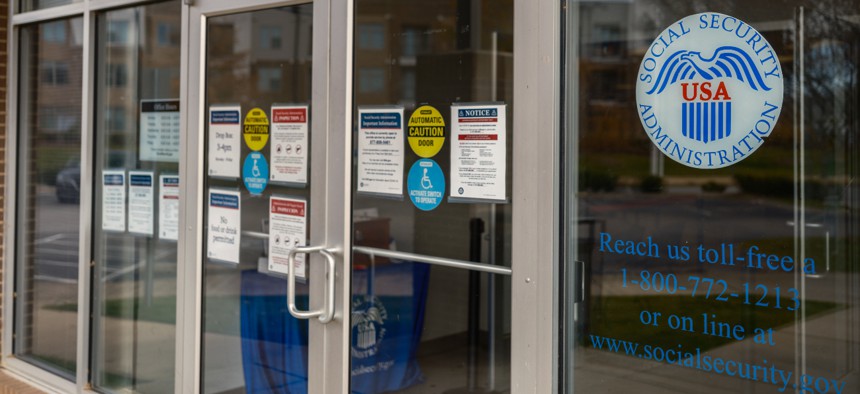
The agency has suffered from chronic understaffing. William DeShazer for The Washington Post via Getty Images
Social Security’s Union Is Calling for $16.5 Billion in Funding and Cooperation from Management
Labor leaders say the only way out of the agency’s staffing crisis is more money and the abandonment of cutthroat collective bargaining tactics by the agency’s Office of Labor-Management and Employee Relations.
Officials at the union representing employees of the Social Security Administration on Thursday called on Congress to provide $16.5 billion in emergency appropriations for fiscal 2023 and on agency management to improve its workforce policies to address a staffing crisis that has created administrative backlogs and long lines at field offices across the country.
At a virtual town hall hosted by the progressive advocacy group Social Security Works and the American Federation of Government Employees, officials said that while the number of Social Security beneficiaries have risen by 21% between 2010 and 2021, funding for the agency to administer those benefits have dropped by 13%, adjusted for inflation. The agency has suffered from chronic understaffing, with more on the way: last spring, the agency told Congress that it expected 4,500 operations employees to leave the agency in fiscal 2022.
“Right now, the agency operates with 4,000 fewer field office and teleservice center employees than it did 12 years ago,” said Sherry Jackson, second vice president of AFGE Council 220, which represents employees at Social Security’s field offices and teleservice centers. “Employees are overloaded, overworked and underpaid, and thousands more are expected to depart in the current fiscal year. The current workforce of less than 60,000 employees is at a 25-year low.”
As part of a continuing resolution to fund the government from October until Dec. 16, Congress approved $100 million in emergency funding for the Social Security Administration to fight attrition. Jackson called that money “an encouraging step,” but said its impact will be “negligible.”
“$16.5 billion in fiscal 2023 funding represents a $1.7 billion increase above the president’s $14.8 billion budget request, but it is the drastic increase that the agency needs to provide the public the services that it deserves,” she said. “60% of these additional funds could be earmarked to increase staffing back to fiscal 2010 levels, with another 18% dedicated to reducing state disability determination backlogs.”
Rich Couture, president of AFGE Council 215, which represents workers in the agency’s Office of Hearing Operations, said that in addition to funding, agency management must work with the union to improve recruitment and retention of employees.
“SSA’s Office of Labor-Management and Employee Relations has impeded progress to improving working conditions for employees, slowing attrition, which in turns slows our ability to provide acceptable levels of service ot the public,” he said. “Since January 2021, the Biden administration has issued several executive orders and policies geared toward improving working conditions, modernizing public service and fostering cooperative labor-management relations to help further those goals . . . Despite these initiatives, we have not seen that partnership agency-wide at SSA, but rather we’ve seen a continuation of the anti-worker attitude perpetuated by the last administration through OLMER.”
In a statement, Social Security Administration spokesman Mark Hinkle disputed the notion that agency management continues to resist the Biden administration’s labor policies.
“We engage often with our employee unions to meet our bargaining obligations,” he said. “Under Acting Commissioner [Kilolo] Kijakazi’s leadership, we were one of the first federal agencies to reach agreements with all our unions on reopening our offices earlier this year, we have reached 47 mid-term agreements with our labor unions, and we secured collective bargaining agreements with two of our unions and will begin renegotiation with our third.”
But Couture said the agency’s achievements in labor relations are only “half the story.” Although Social Security reached an agreement with AFGE office reopening issues in January, it came with a promise to continue negotiations on the component level—one that when employees returned to traditional offices last spring went mostly unfulfilled.
“In reality, every single major agreement we’ve reached only happened after weeks, if not months, of fighting at the bargaining table, complaining to the administration and to Congress about OLMER’s bad faith tactics, and filing grievances and unfair labor practice charges to seek relief,” Couture said. “Every single time. That’s not a functional relationship, much less a partnership. OLMER has refused our requests for full renegotiation of our Trump-era union contract, only agreeing to negotiate limited issues, and refusing to negotiate over the heavy-handed telework policy or the broken performance system that falls harshly on minority, disabled and lower-graded workers.”
Couture said the only agency subcomponent to have successfully developed a collaborative working relationship with its union is the Office of Hearing Operations, which he attributed to the fact that the Office of Labor-Management and Employee Relations was not involved.
“I want to be clear: the acting commissioner inherited OLMER and I’m not 100% sure she’s fully aware of what OLMER is doing,” he said. “In any case, OLMER’s approach is antithetical to the acting commissioner’s agenda, the president’s agenda, and Congress’ finding in the federal labor management relations statute that collective bargaining is necessary for effective and efficient government. These ongoing problems only exacerbate the morale and attrition crisis at SSA.”







